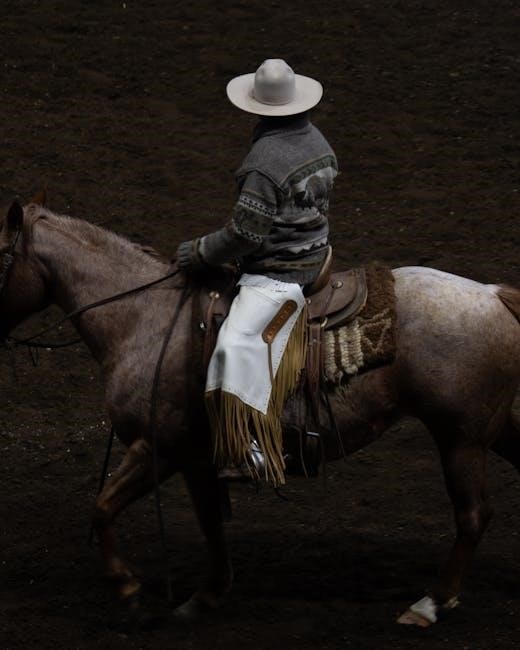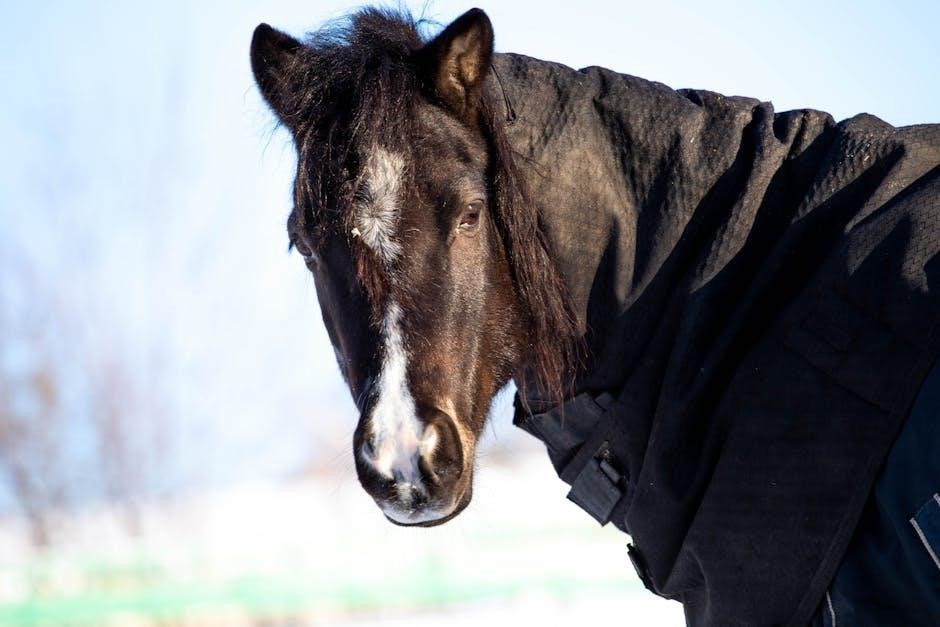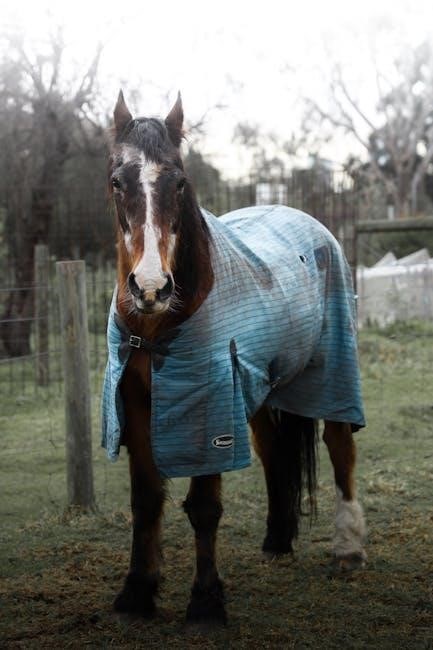
horse blanket guide
Welcome to our comprehensive guide on horse blankets! Learn the essentials of selecting, using, and maintaining blankets to keep your horse warm and comfortable year-round.
Why Horse Blankets Are Essential
Horse blankets are vital for protecting your horse from harsh weather conditions, maintaining body heat, and preventing heat loss. They provide comfort, shield against wind and rain, and are especially crucial for clipped horses. A well-chosen blanket ensures your horse stays warm and healthy, adapting to varying temperatures and seasonal changes. Invest in quality blankets to safeguard your horse’s well-being year-round.
Key Considerations for Choosing the Right Blanket
Selecting the right horse blanket involves assessing your horse’s specific needs. Consider factors like climate, whether your horse is clipped or unclipped, and their individual comfort preferences. Weight, fill, and waterproofing are crucial for outdoor use. Ensure proper fit to prevent rubbing and restricted movement. Durability and ease of care are also important for long-term use and maintenance.

Types of Horse Blankets and Sheets
Explore the variety of horse blankets and sheets designed for different needs. From lightweight sheets to heavy-duty turnout blankets, each type offers unique benefits for your horse.
Lightweight Sheets vs. Heavyweight Blankets
Lightweight sheets are ideal for mild weather, offering protection without heat, while heavyweight blankets provide insulation for colder conditions. Sheets are often used indoors or during spring/fall, whereas heavy blankets are essential for winter, especially for clipped horses. Choosing the right weight ensures your horse stays comfortable without overheating or chilled.
Turnout vs. Stable Blankets: What’s the Difference?
Turnout blankets are waterproof and designed for outdoor use, protecting your horse from rain and wind. Stable blankets are thicker, non-waterproof options for indoor use, focusing on warmth without moisture protection. Turnouts are breathable, while stables prioritize insulation, ensuring your horse stays comfortable in different environments. Choose based on your horse’s needs and where they will be spending most of their time.
Understanding Blanket Weights and Fill
Blanket weights and fill determine warmth levels. Lighter weights are for mild conditions; heavier fills provide insulation in colder temperatures for optimal horse comfort and safety.
How to Determine the Right Weight for Your Horse
Determine the right blanket weight by considering temperature and your horse’s condition. Use lightweight blankets (0–150g) for mild weather, medium weight (150–300g) for cooler conditions, and heavyweight (300+g) for extreme cold. Clipped horses may need heavier blankets sooner. Monitor your horse’s comfort and adjust based on their individual needs and the weather to ensure optimal warmth and comfort.
The Role of Fill in Keeping Your Horse Warm
Fill in horse blankets provides insulation, trapping warm air close to your horse’s body. Higher fill weights offer greater warmth, ideal for colder conditions. Lightweight blankets may have no fill, while heavyweight options use synthetic or natural materials for maximum heat retention. The right fill ensures your horse stays comfortable without feeling restricted or overheated.
How to Measure Your Horse for the Perfect Fit
Measuring your horse accurately ensures a comfortable, proper fit. Use a soft tape measure along the horse’s spine, from the center of the chest to the rear, for precise sizing.
Step-by-Step Guide to Sizing Your Horse
To ensure a proper fit, stand your horse on level ground. Place a soft tape measure along the spine, starting at the center of the chest and extending to the rear. Measure snugly but not too tightly to avoid discomfort. Note the wither height and ensure the blanket length covers from chest to just above the tail. Double-check measurements to avoid errors and ensure the blanket provides a natural protective barrier against the elements.
Common Mistakes to Avoid When Measuring
Ensure your horse stands naturally on level ground to avoid inaccurate measurements. Avoid measuring over thick winter coats, as this can lead to oversizing. Do not pull the tape too tight or leave it too loose, as both can result in poor fit. Measure from the center of the chest to the base of the tail for optimal coverage. Double-check your measurements to prevent errors in sizing.

Weather and Temperature Guidelines
Use a 55°F threshold for blanketing. Below this, horses may need protection. Consider temperature, wind, and rain when deciding blanket weight and type for optimal comfort.
When to Use Light, Medium, or Heavy Blankets
Light blankets are ideal for mild temperatures (50-65°F) to prevent chilling without overheating. Medium-weight blankets suit cooler conditions (30-50°F), offering warmth while allowing mobility. Heavy blankets are best for extreme cold (below 30°F), ensuring maximum insulation. Always consider your horse’s individual needs, such as age, health, and coat thickness, to choose the appropriate weight for comfort and protection.
Temperature Thresholds for Blanketing
The general rule of thumb is to blanket horses when temperatures drop below 55°F. For clipped horses, blanketing is recommended at 40°F or lower, while unclipped horses may need blankets below 50°F. Always consider wind, humidity, and your horse’s individual tolerance to cold. Monitor their comfort and adjust blanketing accordingly to prevent overheating or chilling.
Maintaining and Caring for Horse Blankets
Proper maintenance ensures your horse blankets remain effective. Regularly clean, store properly, and inspect for wear to extend their lifespan and keep your horse warm.
Cleaning and Washing Tips
Regular cleaning is essential for horse blankets to maintain hygiene and functionality. Start by brushing off dirt and debris to prevent damage during washing. Use mild detergents and avoid harsh chemicals or bleach, as they can weaken the fabric. For tough stains, pre-treat before washing. Machine wash on a gentle cycle, and air-dry to prevent shrinkage. Always follow manufacturer guidelines for specific materials to ensure longevity and performance.
How to Store Blankets When Not in Use
Proper storage of horse blankets ensures they remain in good condition. Clean and dry the blankets thoroughly before storing to prevent mold and mildew. Use breathable storage bags or containers to maintain airflow. Store in a cool, dry place away from direct sunlight and pests. Fold or roll blankets neatly to prevent creases and damage. Avoid stacking multiple blankets to ensure each stays fresh and ready for use when needed.
Blanketing and Clipping: What You Need to Know
Blanketing and clipping go hand-in-hand for your horse’s comfort. Clipping affects blanket choice, so consider your horse’s needs, weather, and activity level to avoid overheating or chilling.
How Clipping Affects Blanket Choice
Clipping your horse’s coat removes their natural insulation, impacting their ability to stay warm. This means selecting a blanket with appropriate fill and weight is crucial. Clipped horses typically require heavier blankets to compensate for the loss of their natural coat. The extent of clipping, whether partial or full, will influence the thickness and type of blanket needed to ensure comfort and prevent chilling.
Monitor weather conditions closely, as clipped horses may overheat in milder temperatures. Adjusting blankets seasonally and considering your horse’s activity level will help maintain their well-being. Always choose blankets designed for clipped horses to provide the right level of warmth without causing discomfort.
When to Clip and When Not to
Deciding when to clip your horse depends on several factors, including their workload, climate, and coat thickness. Horses in heavy work or living in warmer climates may benefit from clipping to prevent overheating. However, horses in colder environments or with thick coats may not need clipping, as their natural insulation is sufficient. Always consider your horse’s specific needs and consult a professional if unsure.

Safety Tips for Blanketing Your Horse
Ensure your horse’s blanket fits perfectly to avoid chafing or restricted movement. Regularly inspect for worn areas and loose straps to prevent accidents and skin irritation.
Preventing Rubbing and Skin Irritation
To prevent rubbing and skin irritation, ensure a proper fit by measuring your horse accurately. Choose blankets with soft, breathable lining and avoid tight straps. Regular grooming helps detect early signs of irritation. Rotate blankets seasonally and wash them regularly to maintain hygiene. Always inspect for worn-out areas that may cause friction and discomfort.
Ensuring Proper Mobility and Comfort
Ensure your horse’s blanket allows for proper mobility and comfort by selecting a well-fitted design. Look for features like gusseted shoulders and adjustable straps to prevent restriction. Choose breathable fabrics to regulate body temperature and avoid overheating. Regularly check for signs of discomfort, such as hesitancy to move freely, and adjust or replace the blanket as needed to maintain your horse’s ease of movement.

Seasonal Blanketing Guide
Adapt your horse’s blanketing to match seasonal changes. Use lightweight sheets in spring and fall, medium weights in cooler transitions, and heavy blankets for winter. Adjust based on temperature fluctuations and your horse’s specific needs to ensure comfort and warmth throughout the year.
Spring, Summer, Fall, and Winter Blanketing Strategies
Seasonal blanketing ensures your horse stays comfortable all year. In spring, opt for lightweight sheets as temperatures rise. Summer typically requires no blanketing unless Needed for specific conditions. Fall introduces cooler mornings, so use medium-weight blankets. Winter demands heavyweight options to protect against harsh cold. Always monitor weather changes and your horse’s comfort to adjust accordingly, ensuring optimal warmth and protection in every season.
Adjusting Blankets for Changing Weather Conditions
Monitor temperature fluctuations and precipitation to ensure your horse’s comfort. Layering lightweight sheets under heavier blankets allows for easy adjustments. Remove or add blankets as needed to prevent overheating or chilling. Regularly check your horse’s condition and adjust blanketing accordingly. This adaptive approach ensures your horse stays comfortable through unpredictable weather, maintaining optimal warmth and protection without compromise.
Budgeting for Horse Blankets
Plan your budget by considering blanket quality, durability, and versatility. Prices vary, but investing in high-quality options ensures long-term value and protection for your horse.
Understanding Costs andQuality Differences
Understanding Costs and Quality Differences
Horse blankets vary in price based on materials, design, and features. Cheaper options may lack durability, while high-quality blankets offer superior insulation and longevity. Synthetic fabrics are often more affordable but may not breathe as well as natural materials.
Investing in a durable, well-made blanket can save money over time by reducing replacement needs. Always balance budget with quality to ensure your horse stays warm and comfortable.
Investing in Durable and Versatile Blankets
Durable and versatile horse blankets are a wise investment for long-term use. Look for waterproof, breathable materials that withstand harsh weather conditions and regular wear. Versatile designs, such as adjustable neck closures and removable neck covers, offer flexibility for varying needs.
High-quality blankets with sturdy stitching and reinforced seams provide exceptional durability. They minimize the risk of damage and ensure your horse stays comfortable in different settings, from turnout to stable use.
Understanding when to blanket, choosing the right type, and proper maintenance ensure your horse stays warm and comfortable year-round. Always consult trusted resources for specific needs.
Final Tips for Keeping Your Horse Warm and Comfortable
Regularly monitor your horse’s condition and adjust blankets according to weather changes. Choose the right weight and type based on temperature and clipping. Clean and store blankets properly to maintain quality. Always ensure a proper fit to prevent rubbing. Adjust blankets as weather conditions change, and consult a professional if unsure. Keep your horse warm, dry, and comfortable with these simple yet effective strategies.
Resources for Further Reading and Guidance
Explore comprehensive guides like SmartPak’s Horse Blanketing Guide for detailed insights. Visit Horseware’s website for tips on selecting the right blanket. Check out equine care books for in-depth advice. Follow reputable equestrian blogs for seasonal strategies and product reviews. Consult with equine professionals for personalized recommendations. Utilize online forums and communities for real-life experiences and troubleshooting. Stay informed to ensure your horse’s comfort and well-being year-round.